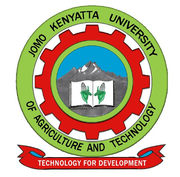
W1-2-60-1-6
JOMO KENYATTA UNIVERSITY
OF
AGRICULTURE AND TECHNOLOGY
UNIVERSITY EXAMINATIONS 2015/2016
SECOND YEAR SECOND SEMESTER EXAMINATION FOR THE
DEGREE OF BACHELOR OF SCIENCE IN PUBLIC HEALTH
MLS 2102: PHYSICS FOR MEDICAL SCIENCES
DATE: APRIL, 2016 TIME: 2 HOURS
INSTRUCTIONS: ANSWER QUESTION ONE (COMPULSORY) AND ANY OTHER TWO QUESTIONS
QUESTION ONE (COMPULSORY) (30 MARKS)
a) Define the term accommodation in relation to the eye.
Describe briefly how the eye is able to focus those objects
which are near and those which are far. [4 marks]
b) 12g of ice require 4032 J of heat energy for it to melt completely.
Calculate the specific latent heat of fusion of the ice given that the temperature remained constant as all the ice melted. [3 marks]
c) A potential of 240V is applied across a resistance device.
This allows a current of 0.096A to flow through the device.
Determine the resistance through which the element flows. [3 marks]
d) The electromagnetic spectrum consists of seven waves.
Draw a table and change the seven waves in their order of
increasing wavelength. Specify the category of waves which
are non ionizing. [4 marks]
e) State THREE disadvantages of alcohol when used as
a thermometric liquid. [3 marks]
f) Ionizing radiation is useful as well as it is harmful. Outline
THREE hazards of ionizing radiation. [3 marks]
g) Substance A decays to form B by production of alpha particles
and beta particles. The reaction is represented by the equation
below.
Determine the values of x and y. [5 marks]
h) State THREE factors that affect the capacitance of a parallel
plate capacitor. [3 marks]
i) Describe how illness/infection affects the basal metabolic rate. [2 marks]
QUESTION TWO (20 MARKS)
a) Explain how the idea of heat capacity is useful in the choice of
thermometer liquids and coolants . [4 marks]
b) A copper block of mass 0.5 Kg was heated to a temperature of
3000C and dropped into water in a container of negligible heat
capacity. The temperature of the water rose from 100C to 750C.
Given that SHC of the water = 4200 J/Kg K and Copper =
400 J/Kg K. Determine:
i) Heat lost by the copper [3 marks]
ii) Heat gained by the water [3 marks]
iii) The mass of the water in the container [2 marks]
c) Outline the main differences between heat transfer by
convection and radiation. [4 marks]
d) Describe resonance absorption and how it is useful in the
absorption of heat by the human body. How does the body
respond to excess heat? [4 marks]
QUESTION THREE (20 MARKS)
a) State and explain FOUR factors that affect electrical resistance. [8 marks]
b) A heating coil has a wire of resistance 800 Ω at a temperature
of 100C. The coil is connected to a 240V main. This causes its
temperature to rise and at a temperature of 900C, the current
flowing in the coil was 0.24V. Determine the temperature
coefficient of resistance of the material of the coil. [6 marks]
c) Current can be rated as a small, large and very large. Explain
how different magnitudes of the currents affect the functioning
of the heat. [3 marks]
d) Other than the magnitude of the current, state THREE other
factors that determine the severity of an electric shock. [3 marks]
QUESTION FOUR (20 MARKS)
a) You are send to a facility as the medical health physicist.
State FOUR roles you must accomplish in the facility. [4 marks]
b) Photosynthesis as the initial process of energy storage takes
place in two stages. Identify the two stages and briefly explain
what happens in each of the stages. [6 marks]
c) Four capacitors of 20µF, 40µF, 100µF, 200µF, are connected
in parallel. A potential difference of 20V is applied across
the arrangement. Calculate:
i) The effect capacitance of the arrangement. [3 marks]
ii) The total charge stored by the capacitors. [3 marks]
iii) The capacitors discharge in a time of 4 x 10-3 S,
determine the strength of current delivered. 3 marks]
d) State one medical application of the capacitors. [1 mark]
QUESTION FIVE (20 MARKS)
a) A compound microscope is made of two lens (objective lens
and the eye piece lens). By use of two rays and an object placed
before the objective lens, show how the compound microscope
forms a magnified image of the object. [6 marks]
b) A radioactive sample has a have life of 20 years. In 2010 the
sample had 4,000 counts, determine the fraction of the original
sample that would have remained by the year 2130. [4 marks]
c) Define thermograph and state FOUR medical applications of
thermograph. [5 marks]
d) State TWO factors that affect the amount of expansion
of a substance. [2 marks]
e) A concrete slab has a length of 30 m at -150C on a winter’s day.
What is the change in length from winter to summer, when the
temperature is 300C?
The linear expression coefficient of concrete is 1.2 x 10-5/0C. [3 marks]